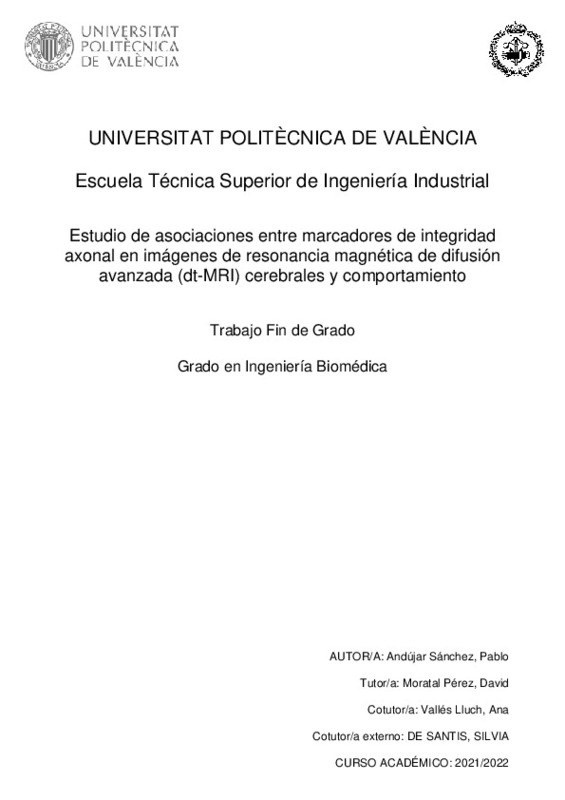|
Resumen:
|
[ES] En el presente proyecto se pretende estudiar cómo se relacionan diferentes biomarcadores de integridad axonal obtenidos a partir de imágenes de resonancia magnética avanzada cerebrales, con variables que miden el ...[+]
[ES] En el presente proyecto se pretende estudiar cómo se relacionan diferentes biomarcadores de integridad axonal obtenidos a partir de imágenes de resonancia magnética avanzada cerebrales, con variables que miden el desempeño cognitivo de diferentes sujetos. Para ello, se empleará el modelo de difusión llamado CHARMED, que permite modelar componentes de difusión correspondientes al movimiento de las moléculas de agua en el espacio intraaxonal de las neuronas, diferenciándolo del movimiento de esta en el espacio extraaxonal, permitiendo realizar estudios más precisos sobre integridad axonal en la materia blanca del cerebro humano.
Así, el objetivo que se persigue es relacionar las medidas obtenidas para los mencionados biomarcadores de integridad axonal con diferentes pruebas utilizadas para medir el grado de destreza que se tiene para los sujetos de la muestra que se pretende estudiar, teniendo como hipótesis que la variabilidad que estos presentan puede explicarse mediante la mencionada relación y, siendo este estudio de especial relevancia de cara a la prevención y la detección del deterioro prematuro en el tejido nervioso respecto a la edad, que puede originarse por diferentes patologías, entre otras causas.
Para ello, se utilizarán doscientos volúmenes cerebrales de resonancia magnética de difusión obtenidos de la base de datos Human Connectome Project, que posteriormente deberán ser procesados con el mencionado modelo CHARMED utilizando Matlab. Puesto que el coste computacional de dicho procesamiento es elevado, se utilizará el cluster de computación del que dispone el Consejo Superior de Investigaciones Científicas (CSIC), llamado Trueno. Respecto a las variables referentes a las destrezas cognitivo-conductuales de los sujetos, estas fueron evaluadas y cuantificadas por Human Connectome Project, y liberadas junto con las imágenes de resonancia magnéticas empleadas en este proyecto asociándolas a los sujetos de estudio.
Este Trabajo Fin de Grado se realizará en estrecha colaboración con el Instituto de Neurociencias de San Juan de Alicante, del Consejo Superior de Investigaciones Científicas-Universidad Miguel Hernández.
[-]
[EN] This project is intended to study the relationship between different axonal integrity biomarkers,
quantified using Advance Diffusion Magnetic Resonance Imaging (dt-RMI) to analyze the
properties of white matter in ...[+]
[EN] This project is intended to study the relationship between different axonal integrity biomarkers,
quantified using Advance Diffusion Magnetic Resonance Imaging (dt-RMI) to analyze the
properties of white matter in different subjects’ brain, and several behavioral scores that these
subjects have obtained in tests that measure their skills in different fields. For that purpose,
CHARMED diffusion model will be used, given that it is able to detect water diffusion in the
intraaxonal mean of neurons but also in the extraaxonal mean of them, allowing to analyze
white matter axonal integrity in a more accurate way in human’s brain. Thus, the purpose of this
project is to correlate the mentioned axonal integrity measures quantified, with the different
skill scores obtained by the subjects studied, being the main hypothesis that subjects’ variability
can be explained by the recent relationship mentioned. This relationship could be important to
prevent and detect early cognitive impairment related to brain’s deterioration which can be
caused by different diseases among other different causes. To achieve this purpose, two
hundred subject brain volumes obtained using dt-MRI will be processed with CHARMED pipeline
using Matlab. These images were obtained from the Human Connectome Project data base.
Regarding the high computational costs of this processing, a computational cluster will be used.
This cluster is called Trueno and it is hosted by Consejo Superior de Investigaciones Científicas
(CSIC). This project will be carried out in close collaboration with Instituto de Neurociencias de
San Juan de Alicante, of the Consejo Superior de Investigaciones Científicas (CSIC) and
Universidad Miguel Hernández (UMH).
[-]
|







